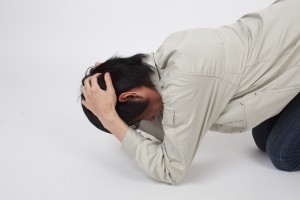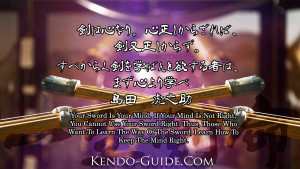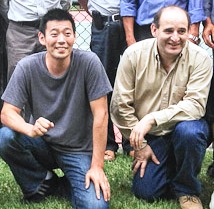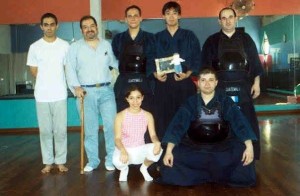Do you agree with having a match or shiai in kendō? Some people do not like shiai because it helps kendō become TOO competitive. Others think that shiai is an important aspect of own training process.
What do you think?
I personally used to NOT like shiai that is because I did a lot of shiai when I was young. But now I think it is very necessary for me to participate in shiai for my deeper study of kendo.
To me the objects of shiai are:
Objects:
- Test your skills
- Test your attitudes
- Test yourself as a person
- Polish up my daily training
It does not matter anytime I do shiai or jigeiko with others, I get nervous. Why do I get nervous? It is because I do not want to get hit. Hitting or getting struck means “death” or “getting hurt” in kendo.
Of course, no one wants to get struck. One of the main purpose of kendo is to overcome this fear. Because we are afraid, we should overcome to execute a proper strike. That is why we always train.
Now I want to introduce a great saying of kendō.
Shiai Should Be Like Keiko. Keiko Should Be Like Shiai
In kendo, it is said that “Shiai should be like keiko. Keiko should be like shiai”. Basically what this means is there shouldn’t be any differences in your kendō under any circumstances.
Many people get serious when they fight in shiai. And also there are many people that they don’t do jigeiko as serious as they are when they fight in shiai.
That is why shiai shouldn’t be any different from your ordinary training.
Based on this principle, in kendō, we do not do shiai to win but to learn about our weaknesses so we can polish up ourselves.
Winning is BAD in Shiai?
Of course, NOT. But many focus too much on winning and forget about other important elements of kendō. Shiai is not a goal of our training. Shiai helps us to know our weaknesses and it gives an opportunity to face directly ourselves.
A victory in shiai shows you that what you have done in your daily keiko is good and your hard work paid off.
A loss in shiai gives you an opportunity to think about your own kendō and to study what you should make better in your daily keiko.
Apart from you feeling upset about your loss, there are only things to gain.
When is shiai bad for you?
When you become arrogant by winning. If this happens then now you loses the purpose of kendō. Maybe winning in shiai is your goal but it is not the purpose of kendō. So unfortunately shiai gives you a bad influence on your kendō training if you become arrogant.
When you start developing sneaky ways to win, then shiai has a bad influence on you. This is especially bad for you.
When you start blaming referees, it is bad. There are times that your referees misjudge and you might lose because of that. However, if you are absolutely stronger than your opponent, then your referees would not misjudge anything. Please do note that when you start blaming others for your loss, kendō won’t teach you anything.
 Accept Your Loss
Accept Your Loss
Then you can improve. If you blame others for your loss, then you will make no effort to look into your own kendō or try to change anything. That is why you must accept your loss.
Do Not Get Used To Losing
Accepting your loss sounds very humble. It is humble. But do not get used to losing. If you get used to losing, you will feel nothing. And you think you are better than anyone else because you accept your loss and you do not brag about your kendō. We call it, “justification”. You are shifting your focus.
If you lost, there was something wrong. That means there is something you should work on. And you should be feeling “upset and frustrated”. And these feelings must turn into “motivation” for your training.
Face It So You Can Improve
It is hard to face the reality because if lost simply you will be upset and question yourself what you have been doing during your keiko. That is the important part. You should be upset but you should turn that into your motivation. And start thinking harder and harder when you can or should strike and how you can avoid getting hit without learning sneaky ways.
This is the ideal relation between shiai and keiko.
Things That You Keep in Mind
Previously, I introduced a saying, “Shiai Should Be Like Keiko. Keiko Should Be Like Shiai”. But of course there are certain things that you have to keep in mind because it is different from keiko.
Main Differences
There are rules and regulations. That is the main difference between shiai and keiko. In jigeiko, for example, there is no limitation in the area you fight. However, in shiai, you have an area you have to fight within, called shiai-jō. If you step out of the shiai-jō, you will be penalized. And if you penalized twice, you will lose one point. This doesn’t happen in keiko, does it?
Another thing is referee. There are people who judge who gets a valid cut. Now it’s not necessarily you agree with it.
There will be 3 referees looking at you and your opponent fighting each other, and they will judge cuts executed from you and your opponent.
In keiko, you and your opponent might not be able to tell who gets a valid cut, but with 3 referees they can give you immediate feedback. So you should execute your techniques where these 3 referees can see you; otherwise, they might miss your valid cut.
Of course, referees learn how to move around so they won’t miss any valid cuts. But they are human. They always make mistakes. Just like you. That is why you have to fight so they can see you and judge correctly.
Therefore, you must know how to fight in shiai.
Train So You Can Control Yourself Under Any Circumstances
In shiai, we have regulations. We have rules. We have referees. And you never know what kind of opponent you will fight.
That is why we must train to keep ourselves under control.
In our daily life, we never know what happens to us. We must deal with different types of people out there every day. We must deal with things that happen to us unexpectedly.
Kendo is a small version of our life. It is small but it really shows our weaknesses, especially in shiai.
So don’t forget your purpose of doing kendo. Shiai is not for you to become arrogant. Shiai is not for you to feel better than others.
Shiai is for you to know your weaknesses and work on them for better self.
That’s what I think.
 Your sword is your mind. If your mind is not right, you cannot use your sword right. Thus, those who want to learn the way of the sword, learn how to keep the mind right. By Toranosuke SHIMADA
Your sword is your mind. If your mind is not right, you cannot use your sword right. Thus, those who want to learn the way of the sword, learn how to keep the mind right. By Toranosuke SHIMADA And when they hit you, accept it. Encourage them. If you hold a higher grade, then it is not so special for you to strike them. But if they strike you, then praise them.
And when they hit you, accept it. Encourage them. If you hold a higher grade, then it is not so special for you to strike them. But if they strike you, then praise them.



